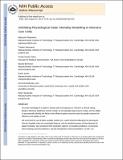Unfolding physiological state: mortality modelling in intensive care units
Author(s)
Ghassemi, Marzyeh; Doshi-Velez, Finale; Joshi, Rohit; Rumshisky, Anna; Szolovits, Peter; Naumann, Tristan; Brimmer, Nicole J.; ... Show more Show less
DownloadSzolovits_Unfolding physiological.pdf (424.8Kb)
OPEN_ACCESS_POLICY
Open Access Policy
Creative Commons Attribution-Noncommercial-Share Alike
Terms of use
Metadata
Show full item recordAbstract
Accurate knowledge of a patient's disease state and trajectory is critical in a clinical setting. Modern electronic healthcare records contain an increasingly large amount of data, and the ability to automatically identify the factors that influence patient outcomes stand to greatly improve the efficiency and quality of care.
We examined the use of latent variable models (viz. Latent Dirichlet Allocation) to decompose free-text hospital notes into meaningful features, and the predictive power of these features for patient mortality. We considered three prediction regimes: (1) baseline prediction, (2) dynamic (time-varying) outcome prediction, and (3) retrospective outcome prediction. In each, our prediction task differs from the familiar time-varying situation whereby data accumulates; since fewer patients have long ICU stays, as we move forward in time fewer patients are available and the prediction task becomes increasingly difficult.
We found that latent topic-derived features were effective in determining patient mortality under three timelines: in-hospital, 30 day post-discharge, and 1 year post-discharge mortality. Our results demonstrated that the latent topic features important in predicting hospital mortality are very different from those that are important in post-discharge mortality. In general, latent topic features were more predictive than structured features, and a combination of the two performed best.
The time-varying models that combined latent topic features and baseline features had AUCs that reached 0.85, 0.80, and 0.77 for in-hospital, 30 day post-discharge and 1 year post-discharge mortality respectively. Our results agreed with other work suggesting that the first 24 hours of patient information are often the most predictive of hospital mortality. Retrospective models that used a combination of latent topic features and structured features achieved AUCs of 0.96, 0.82, and 0.81 for in-hospital, 30 day, and 1-year mortality prediction.
Our work focuses on the dynamic (time-varying) setting because models from this regime could facilitate an on-going severity stratification system that helps direct care-staff resources and inform treatment strategies.
Date issued
2014-08Department
Massachusetts Institute of Technology. Department of Electrical Engineering and Computer ScienceJournal
Proceedings of the 20th ACM SIGKDD international conference on Knowledge discovery and data mining (KDD '14)
Publisher
Association for Computing Machinery (ACM)
Citation
Marzyeh Ghassemi, Tristan Naumann, Finale Doshi-Velez, Nicole Brimmer, Rohit Joshi, Anna Rumshisky, and Peter Szolovits. 2014. Unfolding physiological state: mortality modelling in intensive care units. In Proceedings of the 20th ACM SIGKDD international conference on Knowledge discovery and data mining (KDD '14). ACM, New York, NY, USA, 75-84.
Version: Author's final manuscript
ISBN
9781450329569